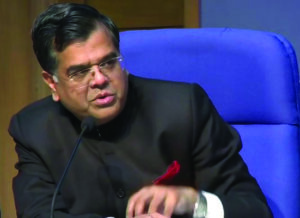
TV Somanathan
- In his poem “Bharata Desam”, the visionary C. Subramania Bharathi dreamt of using the excess water flowing to Bengal to grow crops in central India. He passed away in 1921. A hundred years later, the first river linking project is beginning, through the Ken- Betwa project.
- The 2022-23 Budget is a balanced budget in a different sense: balancing action in the present with vision for the future,ambition in attitude with prudence in practice.
Budgets in a parliamentary democracy serve several purposes. Partly, they are an annual financial statement, a function which is routine but crucial; but they are also statements of policy intent. Unlike the private sector, governments cannot choose their customers — they must serve all. They have not the luxury of concentrating on “core competencies” — they have to do everything Parliament expects. They provide many things free — so demand is much higher than any feasible supply or affordability. They extract taxes — which are as unpopular as they are inevitable. For all these reasons, Budget-making is a hugely complex balancing act.
Budget for capital expenditure increased by over 35%
https://youtu.be/WatTBdw4ldQ
The Budget 2022-23 is a budget for these peculiar times. Its biggest theme is boosting growth and employment through a large increase in public investment for the second year running, while continuing support for agriculture, health, education and welfare programmes. The budget for capital expenditure has been increased by over 35%. The PM GatiShakti programme aims at not merely quantitative expansion in infrastructure, but also a qualitative leap through meticulousplanning. Too often, we have had poor coordination between road and rail, rail and metro, port and road, etc. Integrated planning and execution can considerably increasedomestic productivity and export competitiveness.
Outlay for the PM Gram Sadak Yojana increased by 27%
Another priority is generation of gainful employment. The capital expenditure boost in itself will generate millions of jobs directly and indirectly (through its multiplier effect on other sectors). A special feature is the unprecedented helping hand to States for their capital expenditure through a provision of Rs 1 lakh crores of interest free 50 year loans, additional to their normal borrowing ceiling. The credit guarantee scheme for MSMEs is being revamped to provide a massive Rs 2 lakh crores of new lending. Additional credit to hospitality, tourism and related (pandemic-affected) sectors is being provided through the highly successful Emergency Credit LineGuarantee scheme. The outlay for the PM Gram Sadak Yojana has been increased by 27%. Moreover, supplemental funding will be provided to states to meet their share in respect of certain priority sections.
Farmers to get more benefits

Adequate provisions have been made to support agriculture, including fertiliser subsidies and grain procurement. Apart from the ongoing National Health Mission and AYUSH programmes, the new PM Atmanirbhar Bharat Health Infrastructure Mission will permanently upgrade India’s health capacity. A new, flexible, need-based “PM’s Development Initiative for the North East” (PM DevINE) has been started for projects which may not fit into the parameters of standard schemes. In line with Finance Commission recommendations, 130 Centrally Sponsored Schemes have been revamped and restructured into 65, enabling greater flexibility and impact.
Range of fund allocations, policy initiatives for the India of 2047
While handling the financial predicaments of today, the Budget lays a foundation for solving the policy problems of tomorrow. It contains a wide, carefully conceived, range of fund allocations and policy initiatives for the India of 2047, including world-class indigenous railway technology, ‘kisan drones’for agriculture, ‘drones as a service’, digital health information, telemedicine, electronic passports, digital currency, clean public transport,battery swapping, green hydrogen, coal gasification and universal optic fibre access. Clarity in taxation of crypto-instruments, plugging of loopholes and modernisation of Customs administration of SEZs are important features of the Budget.
In his poem “Bharata Desam”, the visionary C. Subramania Bharathi dreamt of using the excess water flowing to Bengal to grow crops in central India. He passed away in 1921. A hundred years later, the first river linking project is beginning, through the Ken- Betwa project.
Biggest ever single year reduction in fiscal deficit
All of this is combined with a careful fiscal policy to preserve macro-economic stability. In spite of pandemic-related spending and disinvestment shortfalls, high revenue growth and tight expenditure control have enabled the fiscal deficit for 2021-22 to remain at6.9% of GDP, close to its budgeted level. This is the biggest ever single year reduction in fiscal deficit. Next year, the deficit is expected to be 6.4 % of GDP. It is noteworthy that the fiscal deficit is effectively only 6.0% excluding the special transfers to states for capital expenditure. The revenue deficit is estimated to decline even more sharply from 4.7to 3.8% .Without levying new taxes, the Budget adheres to the consolidation trajectory announced in the last budget of reaching 4.5% of GDP by 2025-26, starting from the 2020-21 figure of 9.2%.
In economics, a balanced budget is one where expenditure is equal to revenue. The 2022-23 Budget is a balanced budget in a different sense: balancing action in the present with vision for the future,ambition in attitude with prudence in practice.
(The author of this article is Dr T V Somanathan, Finance Secretary, Government of India)












